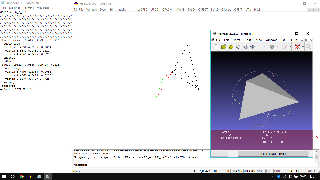|
 |
"Bald Eagle" <cre### [at] netscape net> wrote:
> "Kenneth" <kdw### [at] gmail net> wrote:
> "Kenneth" <kdw### [at] gmail com> wrote:
>
> > I am looking forward to seeing how you solve your too-smooth problem; I wish
> > that I could offer some suggestions. Some of this triangle stuff is outside my
> > knowledge. *If* the triangle normals are all unit length, perhaps your summing
> > operation could be made to eliminate some of the identical normals on large flat
> > areas, which might reduce their contribution-- and make the smoothness less
> > smooth. (?)
>
> Triangles typically have a sinlge normal - a vector that is perpendicular to
> it's face (in either direction).
>
> The normal can be of any length.
>
> Typically, for lighting purposes, since the normal vector is used to calculate
> how light interacts with the surface, you want them of unit length.
>
> For smooth, or perturbed-surfaces, you will specify the normals of the vertices,
> and then POV-Ray will interpolate the normals across the surface, (and perhaps
> adding/multiplying by some pattern) to yield a smoothly changing surface.
>
> When dealing with a mesh of triangles that share common vertices and edges, one
> typically averages all of the normals that meet at a common vertex so that
> there's no sudden discontinuity in the way light reflects from the surface,
> appearing as lump, depressions, or creases.
>
> If you have two triangles oriented in different directions, if you multiply the
> length of the normal of one triangle, its contribution to how the triangles
> behave at that vertex will be greater.
>
> I think in order to accomplish what he's looking to do, the way that the
> triangles get interpolated would have to change, other wise I don't see how to
> maintain a common normal direction on one end, and non-linearly change apparent
> curvature at the other.
>
> It's not something I've played with in detail, but it sure seems like something
> that ought to be explored with test renders, diagrams, normal directions and
> lengths explicitly labeled, etc.
>
> Good instructional articles are what draw computer graphics students and
> hobbyists to any given site for the quality content.
>
> We should have that.
> Right on the home page. Perhaps directing to a specific (new) sub-group titled
> "Articles".
>
> - BW
tx Bw
I am working around this concept. The bad angle is 90 degrees. The vectors are
ever long 1 (red color), so the distance (green) it's approximately 1,4142
(Pitagora).
Around this value I have to eliminate the smoothing. It involves graduating on
the size of the angles. Unfortunately I don't have much training in
trigonometry... it takes me a long time and I don't know the shortcuts in the
formulas, I need time...
TX Again
G. com> wrote:
>
> > I am looking forward to seeing how you solve your too-smooth problem; I wish
> > that I could offer some suggestions. Some of this triangle stuff is outside my
> > knowledge. *If* the triangle normals are all unit length, perhaps your summing
> > operation could be made to eliminate some of the identical normals on large flat
> > areas, which might reduce their contribution-- and make the smoothness less
> > smooth. (?)
>
> Triangles typically have a sinlge normal - a vector that is perpendicular to
> it's face (in either direction).
>
> The normal can be of any length.
>
> Typically, for lighting purposes, since the normal vector is used to calculate
> how light interacts with the surface, you want them of unit length.
>
> For smooth, or perturbed-surfaces, you will specify the normals of the vertices,
> and then POV-Ray will interpolate the normals across the surface, (and perhaps
> adding/multiplying by some pattern) to yield a smoothly changing surface.
>
> When dealing with a mesh of triangles that share common vertices and edges, one
> typically averages all of the normals that meet at a common vertex so that
> there's no sudden discontinuity in the way light reflects from the surface,
> appearing as lump, depressions, or creases.
>
> If you have two triangles oriented in different directions, if you multiply the
> length of the normal of one triangle, its contribution to how the triangles
> behave at that vertex will be greater.
>
> I think in order to accomplish what he's looking to do, the way that the
> triangles get interpolated would have to change, other wise I don't see how to
> maintain a common normal direction on one end, and non-linearly change apparent
> curvature at the other.
>
> It's not something I've played with in detail, but it sure seems like something
> that ought to be explored with test renders, diagrams, normal directions and
> lengths explicitly labeled, etc.
>
> Good instructional articles are what draw computer graphics students and
> hobbyists to any given site for the quality content.
>
> We should have that.
> Right on the home page. Perhaps directing to a specific (new) sub-group titled
> "Articles".
>
> - BW
tx Bw
I am working around this concept. The bad angle is 90 degrees. The vectors are
ever long 1 (red color), so the distance (green) it's approximately 1,4142
(Pitagora).
Around this value I have to eliminate the smoothing. It involves graduating on
the size of the angles. Unfortunately I don't have much training in
trigonometry... it takes me a long time and I don't know the shortcuts in the
formulas, I need time...
TX Again
G.
Post a reply to this message
Attachments:
Download 'clipboard01.jpg' (476 KB)
Preview of image 'clipboard01.jpg'

|
 |




![]()